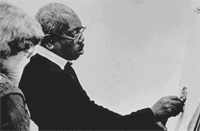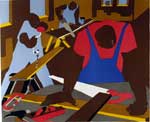VAM galleries including this work:
The Speed Art Museum | Seeing Red | Everyday Life | Art Through Time || VAM Home
Jacob Lawrence (American, 1917-2000)
CARPENTERS, 1977
Offset lithograph; 21-3/4" X 25-7/8"
2000.9.3
The Speed Art Museum
In the late 1960s and throughout the 1970s, Jacob Lawrence explored themes surrounding  construction and building. His 1977 silk-screen print Carpenters was created during this period. In Ellen Harkens’ biography of Lawrence, the artist recalls seeing cabinetmakers at work at the Utopia Children’s Center as a child in Harlem. “In Harlem there were some cabinetmakers named the Bates brothers, who were close to the arts,” Lawrence said. “We all worked together at the center.... They worked with tools that were aesthetically beautiful, like sculpture.” Tools and the hands that wield them figure prominently in Carpenters.
construction and building. His 1977 silk-screen print Carpenters was created during this period. In Ellen Harkens’ biography of Lawrence, the artist recalls seeing cabinetmakers at work at the Utopia Children’s Center as a child in Harlem. “In Harlem there were some cabinetmakers named the Bates brothers, who were close to the arts,” Lawrence said. “We all worked together at the center.... They worked with tools that were aesthetically beautiful, like sculpture.” Tools and the hands that wield them figure prominently in Carpenters.
From the 1960s onward, Lawrence devoted much of his time to printmaking. The rich colors and broad, flat forms achieved by the screen-printing technique appealed to his aesthetic sense.
About the Artist
Jacob Lawrence, one of the foremost African-American artists of the 20th century, was born in Atlantic City in 1917. His family moved to New York’s Harlem neighborhood in 1930. When he was 15, he enrolled in the Harlem Art Workshop at the 135th Street branch of the New York Public Library. The talented young artist soon developed a bold, unique style. At the age of 20, he had his first one-man exhibition of Harlem scenes.
In 1939, Lawrence’s series of panels of the Haitian general Touissant L’Ouverture was shown in an exhibit of American artists co-sponsored by the Harmon Foundation and the Baltimore Museum of Art. The 60 11" X 19" tempera paintings that make up the series proved to be the main attraction of the exhibit. In his review of “Invisible Americans” for the New York Times, Hilton Kramer claimed that the exhibition would have had more force if it had been devoted exclusively to Lawrence’s paintings of the 1930s. The L’Ouverture series was soon followed by narrative series dealing with the abolitionists Frederick Douglass and Harriet Tubman and Lawrence’s impressive series “Migration of the Negro.”
In 1947, Bauhaus master Josef Albers invited Lawrence to teach at Black Mountain College, the tiny avant-garde art school in North Carolina where many of the artists who were eventually to become prominent in the New York School of Painting were then in residence. After leaving Black Mountain, Lawrence taught at the Art Students League, Brandeis University; the New School for Social Research in New York; the California State College at Hayward, an experimental school designed to meet the needs of “third world” students; Pratt Institute; and the University of Washington in Seattle, where he remained until his retirement.
Lawrence’s distinctive narrative painting style was based on simplified forms derived from Cubism and Expressionism. In creating panels for a series, he penciled in each scene and then applied each color in turn wherever it was called for throughout the series. As a result, all panels were in progress simultaneously, and all were completed at approximately the same time. To keep the colors coordinated, he would mix a large quantity of color and apply it to a specific area on each panel. He developed this approach as a youngster while duplicating patterns on his mother’s rugs that fascinated him.
Lawrence represents the first generation of artists who were nurtured by the African-American experience. He was taught and inspired by Africans and Americans. When asked about his imagery, Lawrence replied, “In the Harlem community as in many communities throughout the country, there was a great interest in Negro history. I guess this was during the Marcus Garvey period. We had teachers in the community and after-school Negro history clubs; I used to go to them. We had Negro history sessions at the YMCA, and I became fascinated with Negro history. I guess it was part of my search for an image.”
Classroom Ideas
Discussion: Do a visual inventory of the artwork. Which color stands out the most? Why do you think the artist chose to put this color mainly in the foreground of the piece? Why do you think all the faces are painted without much detail? What shapes do you see repeated throughout the print? View other works by Lawrence and sculptor Ed Hamilton to compare the way they portray figures from history.
Compare this work to others that deal with working people as the subject matter. Artists that you can draw upon for this subject matter would be Gustave Courbet, Jean Millet, Elizabeth Catlett, and Louisvillian Mark Priest. (The video segment “Expressionism: Figurative Art” on the Spectrum of Art DVD features Priest, and images of his work can be found on KET’s Looking at Painting web site.)
Compare the depictions of working people with artworks showing nobility or celebrities. (For examples, see the portraits of Colonel Joseph Hamilton Daveiss and George IV in the Owensboro Museum of Fine Art gallery.) Also view portraits by Sir Anthony Van Dyck, Joshua Reynolds, Thomas Gainsborough, and Jonathan Singleton Copley. Compare the composition and the elements of art in portraits of subjects with a more privileged background and those who earn a living by the sweat of their brow. How do you feel about having working people as the subject for a painting? Why might an artist choose one or the other group as a subject to paint?
Activities: Choose a work activity, such as carpentry, bricklaying, or housecleaning, and draw or paint it in the style of Jacob Lawrence’s Carpenters. Have a friend or classmate model the various activities so you can draw the figures and poses more effectively. Emulate Jacob Lawrence’s simplified approach to the overall design and background of the artworks. Write an artist’s statement about your work.
Interview people who make their livings primarily working with their hands or through their physical strength. Possibilities include maintenance staff, groundskeepers, construction workers, assembly-line workers, and bricklayers. Find out how your interview subjects came to their work, what satisfaction they derive from their jobs, and what they have learned in their work. Think about the connections between your life and the work of your interview subjects. For example, the worker who paves roads for a living helps ensure that you have a road on which to ride the bus to school. Give a report on your interview subjects or ask a subject to visit the classroom.
Writing Prompt:
Grade Level: Intermediate
Prompt: Sometimes when people work together, they make up stories or songs to pass the time. What kinds of stories or songs would these carpenters tell or sing? Make up a song and use objects from the painting in the lyrics (hammer, saw, drill, etc.).
Links
The Whitney Museum’s excellent Jacob
Lawrence: Exploring Stories site includes information, images, and activity
ideas.
[www.whitney.org/jacoblawrence]
Read an interview with Jacob Lawrence in the Smithsonian Institution’s Archives of American Art.
[www.archivesofamericanart.si.edu/oralhist/lawren68.htm]
The Getty Museum’s ArtsEdNet site includes additional information and activities relating to the Lawrence’s work.
[www.getty.edu/artsednet/resources/jacoblawrence/index.htm]
See images of works by Mark Priest at KET’s Looking at Painting web site.
[www.ket.org/painting/gallery/gallery40.htm]

